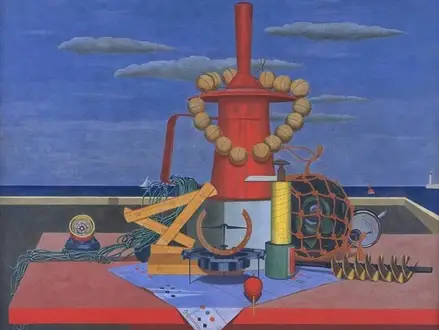Title of Artwork: “Regalia”

Artwork by Edward Wadsworth
Year Created 1928
Summary of Regalia
‘Regalia’ depicts a tabletop display of nautical instruments leading to a seaside terrace. Compass, surveyor’s chain, surveyor’s rule, harbour signals chart, inclining sundial, fishing float, vertical sundial, glass net float, portable tachometer, and auger are the devices that may be identified from left to right.
All About Regalia
These artefacts, with one possible exception: two sundials, are thought to date from the late eighteenth to early nineteenth centuries. Since its light may be turned off by an opening in its side (referred to by some as a “Dark Lantern”), the enormous red item draped with a string of cork floats is a ship’s lantern (port).
‘An equipment for cleaning tubes, consisting of a spiral of brass bristles on a metal stem,’ she says of the auger described above. There are several ways in which the artist acquired these and similar things. Some were purchased from ship chandlers, others were found discarded, and still others were gifted to him by others.
The instruments in the picture are no longer in the possession of Mrs. von Bethmann-Hollweg.
Dairy House at Maresfield Park, Sussex is where ‘Regalia’ was painted by the artist in 1928. He put up the instruments to create an arrangement of still life. There are no actual views of the sea in this still-life painting by Wadsworth; it’s all just an imagined picture.
Marseilles, France, inspired Wadsworth to begin painting maritime still-lifes in 1926, when the artist visited.
The sea still-life was his primary focus until 1929, when he began moving toward biomorphic abstraction in his work. Shells and sundials are just two examples of the maritime still-life lexicon that comprises both organic and man-made shapes.
It wasn’t until 1928 that he took a step back from nature. As with the paintings depicting ships in harbour that came before them, the older still-lifes were often set against a harbour setting; however, the still-lifes from 1928 are almost exclusively set against an empty or nearly empty seascape. Nothing moves on the surface of the water in ‘Regalia’ save for a small yacht and a buoy.
This idea of juxtaposing a still life and landscape became popular in England as early as 1926, and by 1928 it had become a signature style of the Seven and Five Society’s paintings, particularly those by David Jones, Ben and Winifred Nicholson and Christopher Wood and even Paul Nash’s work, despite his lack of membership in the group.
Popular on the Continent, where de Chirico and Herbin were prominent practitioners and Wadsworth was familiar with reproductions of their work as early as 1921 as a result of his subscription to L’Esprit nouveau, of which he owned six volumes and to Léonce Rosenberg’s Bulletin de L’Effort Moderne, of which he was a subscriber from January 1924 until December 1927, was particularly popular.
Information Citations
En.wikipedia.org, https://en.wikipedia.org/.
























